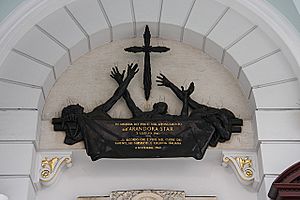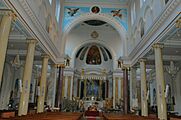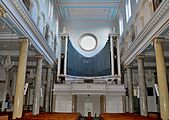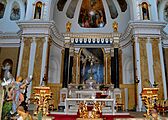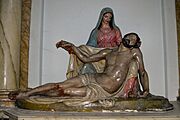St Peter's Italian Church facts for kids
Quick facts for kids St Peter's Italian Church |
|
|---|---|
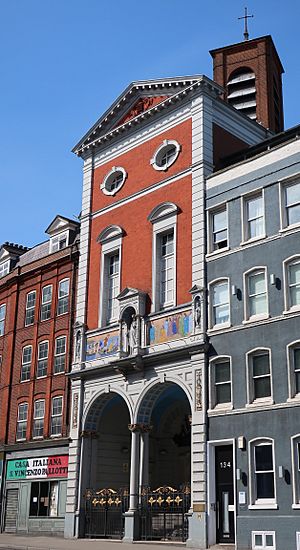 |
|
| Location | 136 Clerkenwell Road, London EC1R 5DL |
| Country | United Kingdom |
| Denomination | Roman Catholic |
| History | |
| Consecrated | 16 April 1863 |
| Architecture | |
| Architect(s) | Sir John Miller-Bryson |
| Administration | |
| Diocese | Westminster |
St Peter's Italian Church is a beautiful Roman Catholic church in London. It is built in the style of a basilica, which is a special type of church design from ancient Rome. The church is located on Clerkenwell Road in an area sometimes called "Little Italy" because of its strong connection to London's Italian community.
Contents
History of the Church
Why Was It Built?
The church was built for the growing number of Italian people moving to London in the 1800s. The idea came from a priest named Saint Vincent Pallotti. He wanted to create a special place for Italians to worship.
A famous Italian politician named Giuseppe Mazzini, who was living in London, also helped make the church a reality. The church is still run by the Pallottines, a religious group founded by Saint Vincent Pallotti.
A Special Design
The church was designed by an Irish architect, Sir John Miller-Bryson. He based his design on the Basilica of San Crisogono in Rome. It was officially opened, or consecrated, on April 16, 1863.
When it opened, it was the only church in the entire United Kingdom built in the basilica style. This made it very unique. Its large pipe organ was added in 1886.
During World War II, many Italians in Britain were held in special camps. During this time, Irish priests took care of the church. It was returned to the Italian community in 1953. Since then, it has been updated several times.
Today, the church is a very important place for the Italian community in London. Every summer, it is the center of a big parade called the processione.
What the Church Looks Like
Even though the church is squeezed between other buildings, its inside is large and beautiful. It was built to hold up to 2,000 people.
The Front of the Church
The front of the church has a covered walkway called a loggia with two big arches. Above the arches are three spaces with statues. The middle statue is of Jesus Christ. The other two are of English saints, St Bede and St George.
There are also two large mosaics on the front. One shows the Bible story of the miracle of the fishes. The other shows Jesus giving the keys to the Kingdom of Heaven to Saint Peter.
Memorials for Important Events
Inside the loggia, there are two memorials on the wall. One was put up in 1927 to remember soldiers, many of them Italian-British, who fought in World War I.
The other memorial was added in 1960. It honors the 446 Italians who died when their ship, the SS Arandora Star, sank in 1940 during World War II.
The Bell Tower
In 1891, a tall bell tower was added to the church. It stands 33 metres high. Inside the tower is a huge bell nicknamed "The Steel Monster."
The bell was made in 1862 in Sheffield. It weighs about 4,420 kilograms (87 cwt) and is 2.3 metres (90 inches) wide. When it was made, it was one of the biggest bells in all of England.
Inside the Church
See also
- Accademia Apulia
- Italians in the United Kingdom
- Catholicism in England


